|
|
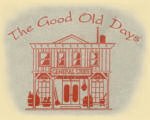 |
Clark County Press, Neillsville, WI April 12, 1995, Page 20 Transcribed by Dolores (Mohr) Kenyon. Index of "Oldies" Articles
|
|
|
 |
Clark County Press, Neillsville, WI April 12, 1995, Page 20 Transcribed by Dolores (Mohr) Kenyon. Index of "Oldies" Articles
|
Good Old Days
By Dee Zimmerman
Each community, village or city within Clark County has churches of different denominations.
The first settlers, coming to the area, who were of a religious group, were the Mormons, arriving in 1844. They chose to settle in the Cunningham Creek area located a short distance south of Neillsville. The large white pine at that site was the deciding factor in choosing that area as it would produce ideal lumber for a tabernacle. However, many disagreements amongst themselves resulted in their short stay. They left the location, returning to Illinois and then on to Utah, later.
The next group of early settlers to arrive in the southern part of the county was of English, Scotch and Irish descent. The O’Neill brothers, James and Henry, were influential in encouraging the beginning of Neillsville Methodist Congregation in 1847. Other denominations began starting congregations and building their places of worship within the county.
Sparks of the Roman Catholic faith were first brought to Clark County by the fur traders who came down from Canada in the late 1840s. Early parish records reveal that the congregation of St. Mary’s, at Neillsville, was established in 1878. In that same year, a small church was built. The first church was of frame construction, veneered with brick, costing $3,500. Three years later in 1881, there were 100 families in the congregation. In 1884, Father Joseph Volz, the first resident pastor, was transferred from Humbird to Neillsville.
Father Volz administered most of the priestly duties on horseback as bridges were few and dirt paths, not roads, had to be traveled to the parishioners. Father Volz went the circuit of lumber camps and every six weeks said Mass in Neillsville. He became resident pastor in 1885. Just as it was difficult for Father Volz to perform his duties to St. Mary’s parish, it was also hard for the early members to attend Mass. A trip to Neillsville to attend Mass during the rigors of winter weather wasn’t easy.
The educational interests of St. Mary’s congregation to start a parochial school initiated building in 1887. In 1897, an addition was made to the church for a sanctuary and a sacristy. Father Volz left Neillsville to take-up pastoral duties in Menomonie in 1897. At that time there were 125 families as members of the congregation and the school had a regular attendance of 75 children, with classes conducted by two Franciscan Sisters.
A summer thunderstorm in June 1923 brought tragedy to the church building. Lightening struck the bell tower, causing a fire that destroyed the original edifice. Heat from the fire was so intense that the brick walls literally melted. Plans to rebuild were soon made.
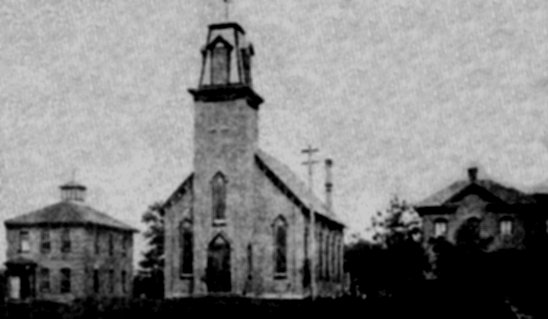 |
|
St. Mary’s Catholic Congregation of Neillsville was established in 1878. That same year, they built a small church on the city’s north side. The building was destroyed by fire in June of 1923 when a bolt of lightning struck the bell tower during a thunderstorm. |
The cornerstone of the new church was laid in 1924, and the building was completed soon after. Father Peter Weber was pastor at that time. He and the congregation worked, (to) bring together the church and remodeling the school. The second church stands yet today. On March 16, 1938, Father Weber died and was buried in the parish cemetery.
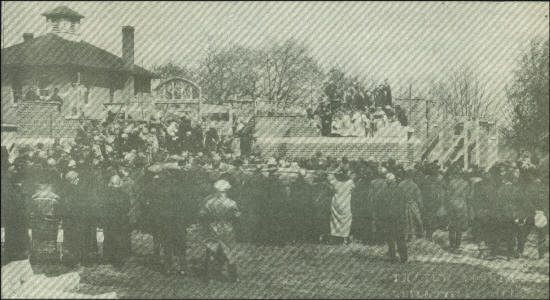
|
The cornerstone for a new St. Mary’s Church building was laid in 1924 and construction was completed the same year. This photo is believed to have been taken during the cornerstone dedication service as members of the congregation gathered at the site on Neillsville’s north side. (Photo courtesy of Ed Statz) |
The second parochial school building was completed in 1939, with a registration of 84 pupils. Classes were conducted by the School Sisters of Notre Dame. Building committee members were: Frank Reinhard, B. J. Haas, Joseph Zilk, Francis Welsh, Thomas Kelly, W. J. Landry, Frank Schmidt, Nick Linster, Leo Wasserburger, Henry Langreck and Carl Gassen.
Through the years, there have been additional remodeling projects to the church so as to serve the worship needs of its congregation. The Rev. Joseph Henseler is the present pastor, having transferred here from Alma Center, to succeed Father Brady, in 1974.
¤¤¤¤¤¤¤¤¤¤¤¤¤¤¤
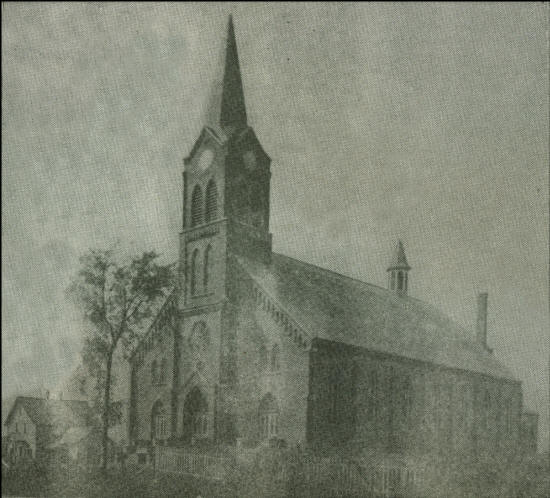
|
St. Hedwig’s Catholic Church, Town of Withee, east of Thorp, near old Highway 29 (now Hwy X) as it appeared circa 1920. The building still stands but hasn’t been occupied by a congregation for several years. |
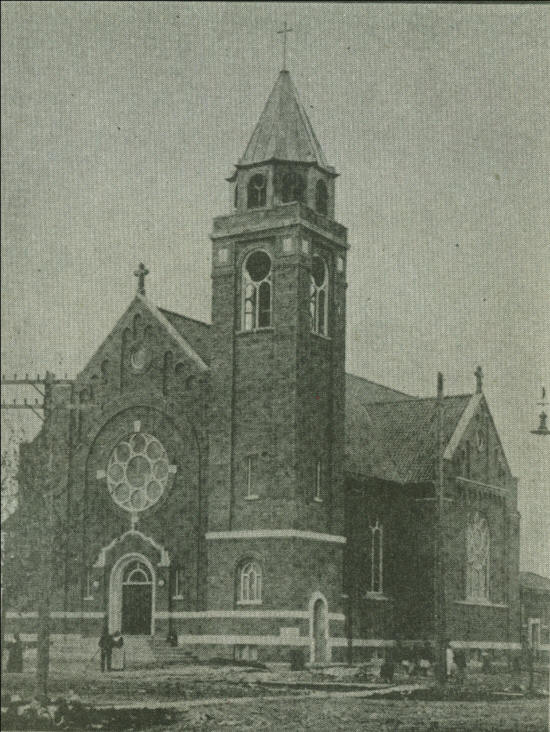
St. Bernard’s Catholic Church of Thorp, a view shortly after its construction was finished in the early 1900s
¤¤¤¤¤¤¤¤¤
The art of being wise is the art of knowing what to overlook. – William James
¤¤¤¤¤¤¤¤¤
Hope is a much grater stimulant of life than any happiness. – Friedrich Nietzsche
¤¤¤¤¤¤¤¤¤
Politeness is like an air cushion: there is nothing inside but it softens the shocks of life. – Schopenhauer
|
© Every submission is protected by the Digital Millennium Copyright Act of 1998.
Show your appreciation of this freely provided information by not copying it to any other site without our permission.
Become a Clark County History Buff
|
|
A site created and
maintained by the Clark County History Buffs
Webmasters: Leon Konieczny, Tanya Paschke, Janet & Stan Schwarze, James W. Sternitzky,
|